Algebraic Notation Chess Guide: An Introduction to Recording Moves
⭐⭐⭐ Take 10 minutes to read and improve your chess game ➡️ : This article was first published on, and is Copyright of Chessquestions.com
Learning chess notation is one of the most important aspects of being a competitive player. It’s not an easy task to learn, but it is made easier with a few simple steps and this guide! The first step in mastering algebraic notation is understanding all the symbols used for recording chess moves on paper.
Algebraic Notation in chess is a written system used by FIDE, Computers, and chess players for recording moves in a game of chess; identifying moved pieces, the ultimate destination of the piece, while special symbols indicate if captures, checks, promotions or checkmates have been achieved.
In this article, I’ll provide a complete list of all piece abbreviations, as well as links to resources that have coordinates for chess boards so that you can reference them online or offline when writing your moves down on paper.
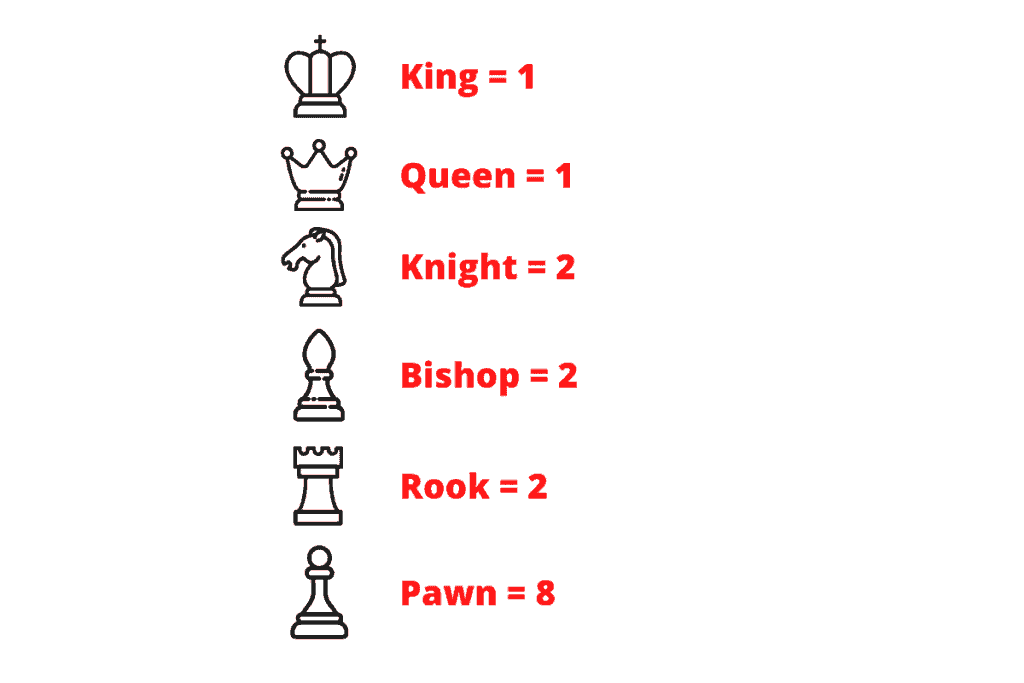
Finally, we’ll walk through what each different type of symbol means in order to give you the knowledge needed to be able to record chess moves and compete in chess competitions.
Just a few minutes of learning chess notation will place you in a better position to learn chess more quickly, allowing you to analyze expert games, write down moves yourself, and is essential if wanting to enter official chess tournaments. Read on, it is much easier than you might imagine.
Learn Chess Notation
You are about to learn everything you need to know about chess notation, and there are a couple of things you need to prepare.
- A pen and paper
- A chess board [either real or computer]
- Ten minutes
Algebraic Notation Abbreviations, Coordinates, and Symbols
Each chess piece has its own Abbreviation and starting position on the board which is also numbered with a coordinate. Additionally, there are symbols to signify captures, and checks during a chess game among other things.
Abbreviation
The King, for instance, is abbreviated as K. The Rook is abbreviated as R.
The table below provides each of the abbreviations and the numbered and lettered square of each chess piece starting position with a standard chess board set up.
| # | Chess Piece | Letter | White Position | Black Position |
|---|---|---|---|---|
| 1 | King | K | e1 | e8 |
| 2 | Queen | Q | d1 | d8 |
| 3 | Rooks | R | a1 and h1 | a8 and h8 |
| 4 | Knights | N | b1 and g1 | b8 and g8 |
| 5 | Bishops | B | c1 and f1 | c8 and f8 |
| 6 | Pawns | No letter | a2, b2, c2, d2, e2, f2, g2, h2 | a7, b7, c7, d7, e7 f7, g7, h7 |
Each piece is designated by a single letter abbreviation. It is the first letter of its name in the English language, which is a capital letter. Internationally, the local language and piece names will be relevant, but for now, we are in English
Example: K=king, Q=queen, R=rook, B=bishop, N=knight.
Because we have two pieces with K, the King takes precedence of course, and the knight adopts Letter N
So, the Queen making a capture on the d5 square would be written Qxd5
The pawn does not have an abbreviation and just the pawn chess moves are recorded, understood that the absence of a letter signifies it is a pawn.
This is why you will see the move 1. e4 written signifying the first move of the game where the white pawn in front of the king on the e file moves 2 squares forward to the 4th rank –
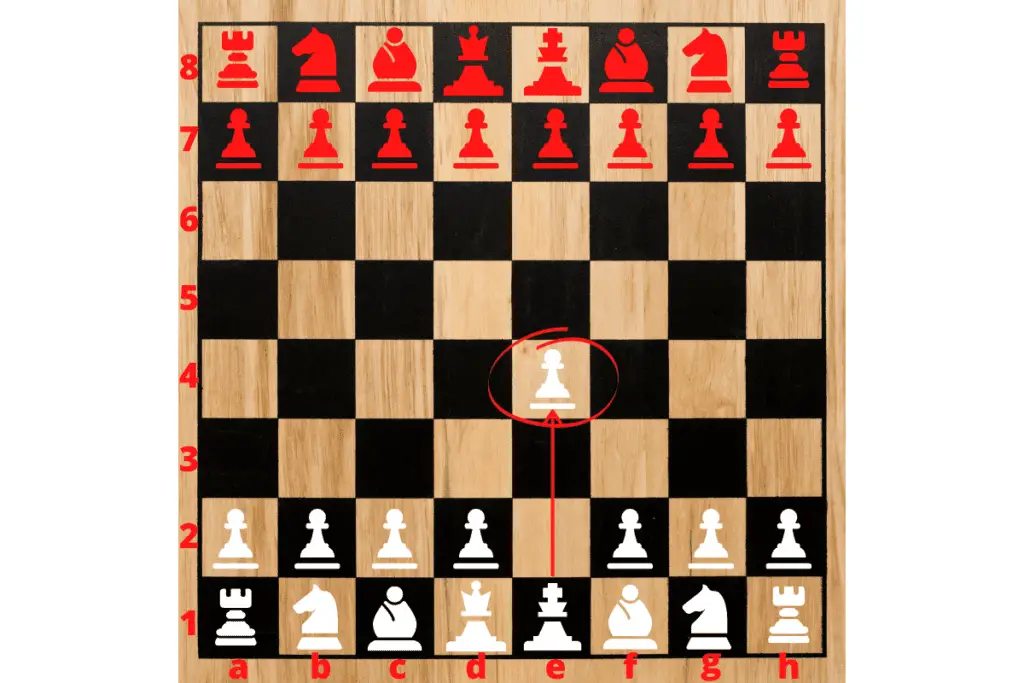
So let’s move things forward a couple of moves, here we have the response from black to make a first pawn move 1…e5 and white releases a Bishop to c4 – so this is written 2. Bc4
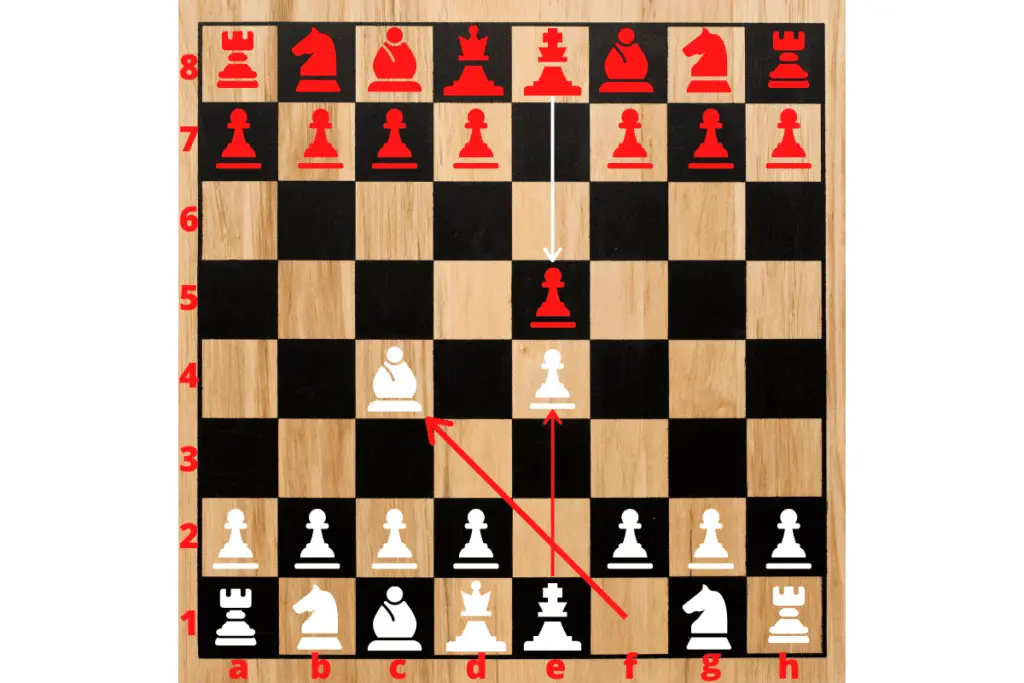
There is one exception to recording pawn moves whereby notice has to be made from whence the pawn began the move and that is for captures.
A pawn capture must record the file of departure, the addition of an x which signifies the capture, and finally, the square upon which the capture was made and the pawn now resides.
Examples: dxe5, gxf3, axb5. See below the special symbols section for information on how to record en passant pawn captures.
Chess Board Square Numbers and Letters
You’ll have to learn the chess board numbers and letters for this too, but that’s pretty easy and this guide will help.
Quite simply for this guide,
- Files are read left to right on the side of the white pieces of the board, A, B, C, D, E, F, G, H.
- Then the ranks move up the board 1, 2, 3, 4, 5, 6, 7, 8.
if you are sitting behind the black pieces then everything is reversed.
8 FILES x 8 RANKS = 64 SQUARES ON A CHESSBOARD – each with an individual identifying letter and number.

Chess Board Numbers & Letters (Orientation, Notation & Buying)
How to Record Special Moves in Chess Notation
There are a number of special moves in chess and some others that are not as straightforward to write down in a logical or lateral thinking process, so they have to be addressed here
- ‘en passant’ = ‘ep’
- pawn promotions [to queen] = ‘=Q’
- castling ‘0-0’ or ‘0-0-0’
En passant
En Passant requires a bit more information in the notation, as we have a pawn-on-pawn capture.
So here we need to first mention the root file of the attacking pawn [e], the capture [x], and the finishing position of the pawn [d3] – The addition of [(ep)] to this notation indicates that the white pawn that has just moved to d4 is the captured piece.
So here we have ‘exd3[ep]‘
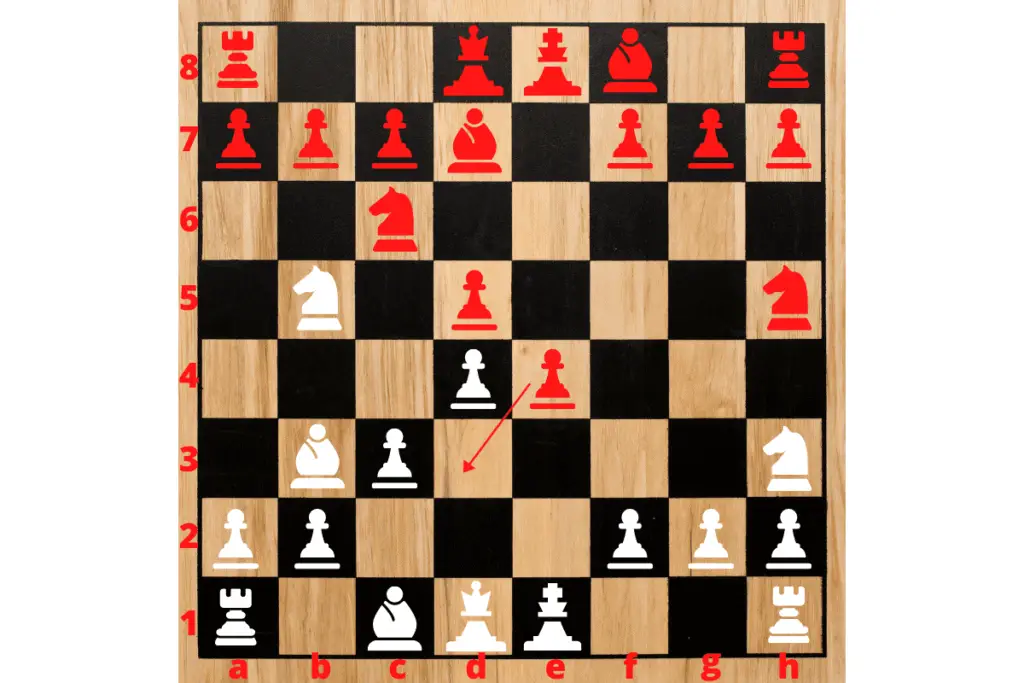
Because ‘en passant’ can only be achieved after the opposing pawn has moved forward two squares, we know the preceding move on the score sheet will read ‘e4’
Pawn Promotions
With pawn promotions, it is a simple case of writing the move as you would, and then adding an ‘=’ sign and the identifier of the promotion choice, usually ‘Q’ for a Queen
So you would have something like g8=Q
Another scenario would be if the pawn was capturing at the same time, so now we would have to include the ‘x’ to signify the capture within the promotion move, so now we have
fxg8=Q if moving from the f file to make the capture.
There is of course the possibility of achieving check or even checkmate from this move too, so the addition of ‘+’ or ‘++’ is possible too
so – fxg8=Q++
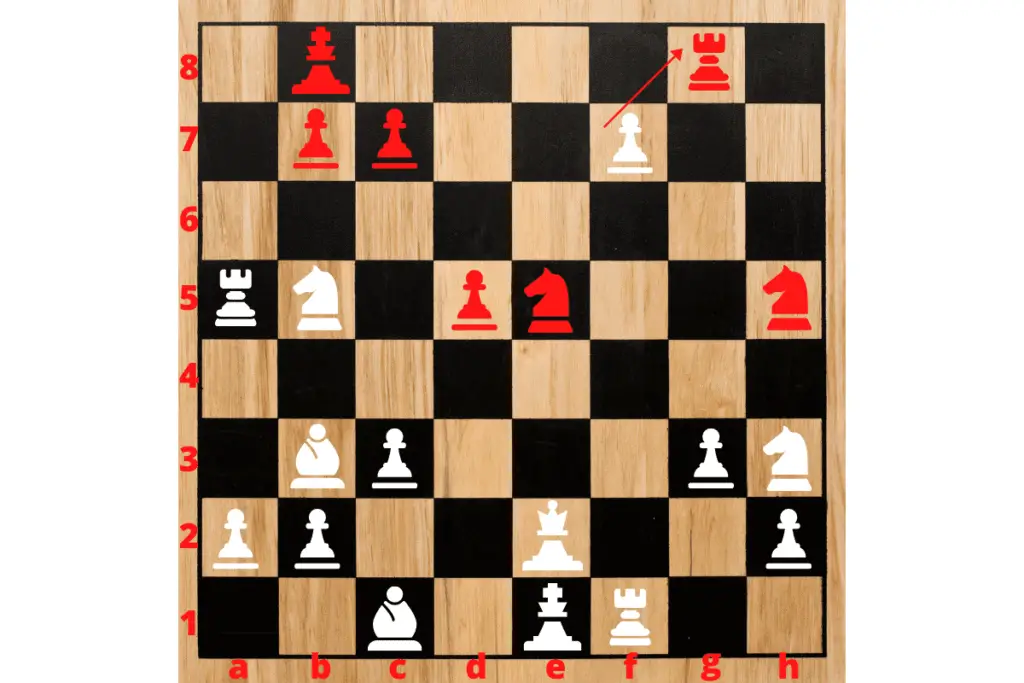
That is about as complicated as chess notation gets, but as you can see, it is very logical and doesn’t take much to understand.
Castling
Writing chess notation for Castling is very easy, you have a choice of two options when making the move, and two simple ways of recording the move
- Castling on King side = ‘0-0’
- Castling on Queens Side = ‘0-0-0’
For more information on castling, take a look at my comprehensive guide on castling that not only describes how and when the move can be made but provides some example of when to castle, when not too, and also some examples of recorded genius castling moves from history
Castling in Chess (How – Conditions – Rules & When)
And one final situation to identify which of two pieces the same has made a capture
This is a situation that you will rarely be faced with, in that, you have two pieces the same with which you can make a capture of one of the opposing pieces.
In this example, the black bishop is on row 1 and is now open to capture from either the White Rook on a1, or e1.
In this case, it would not be enough to simply write Rxc1, because it would not be immediately clear which Rook had made the capture.
To avoid confusion and make it clear you have to indicate which Rook by way of noting the file letter, in the same way, you would from a pawn capture.
So in this example, using the Rook on e1 to make the move, we note – Rexc1

- R = The Rook
- e = from file e
- x = captures
- c1 = on square c1
Annotating Chess Moves
To ‘annotate’ is to make notes to provide comments or explanations. Whilst recording moves in a chess game, you may want to add a little more than just the bare move itself, adding a comment or observation.
For this purpose, there are common abbreviations or ‘Annotations’ that can be added to the moves which serve as both your notes and notes that anyone viewing the scoresheet would understand.
List of Chess Annotation Symbols
| Symbol | Comment |
|---|---|
| ?? | Blunder |
| ? | Mistake |
| ! | Good move |
| !! | Excellent move |
| !? | Interesting move |
| ?! | Dubious move |
It is very possible to have annotations outside of these that mean something to you. indeed, a ‘???’ has been recorded for a very bad blunder and conversely, ‘!!!’ for an exceptional move. But these are personal choices rather than standard notes.
There are further annotations that may make a note of the ‘position’ of the game at the time the move has been made in terms of how the strategic balance of the game is perceived by the note maker.
| Symbol | Note |
|---|---|
| = | Equal on balance |
| +/= or ⩲ | Slight advantage for white |
| =/+ or ⩱ | Slight advantage for black |
| +/− or ± | Clear advantage for white |
| −/+ or ∓ | Clear advantage for black |
| + − | A decisive advantage for white |
| − + | A decisive advantage for black |
| ∞ | Unclear balance |
| =/∞ | Compensation |
What is Figurine Notation in Chess
Whilst this article has based around algebraic notation for chess there are alternatives, the most popular of which is Figurine Notation – Let’s find out the differences and what figurine chess notation is.
Figurine notation is chess is an alternative notation to algebraic which provides no language barrier for use. Capital letters are replaced by chess piece icons, the pawns are omitted as in standard algebraic and it is mostly seen utilized in online chess and computers.
Standard & Figurine Algebraic Notation Comparison Table
| Move | Standard Algebraic | Figurine Notation |
|---|---|---|
| 1. | e4 – e5 | e4-e5 |
| 2. | Nf3 Nc6 | ♘f3 ♞c6 |
| 3. | Bb5 a6 | ♗b5 a6 |
| 4. | Bxc6 dxc6 | ♗xc6 dxc6 |
Special Symbols
More abbreviations and symbols are used in specific instances as follows
- 0-0 = castling with rook h1 or rook h8 (kingside castling)
- 0-0-0 = castling with rook a1 or rook a8 (queenside castling)
- x = captures
- + = check
- ++ or # = checkmate
- e.p. = captures ‘en passant’
For pawn promotion, the Initial of the piece chosen would be appended to the notation, for instance, e8Q for promotion to the queen, or e8N for Knight, and so on.
Win with Pawn Promotion – (Rules – Tips & Strategies)
Example Capture Recorded in Algebraic Notation as Nxe5 – Knight Captures Pawn on e5
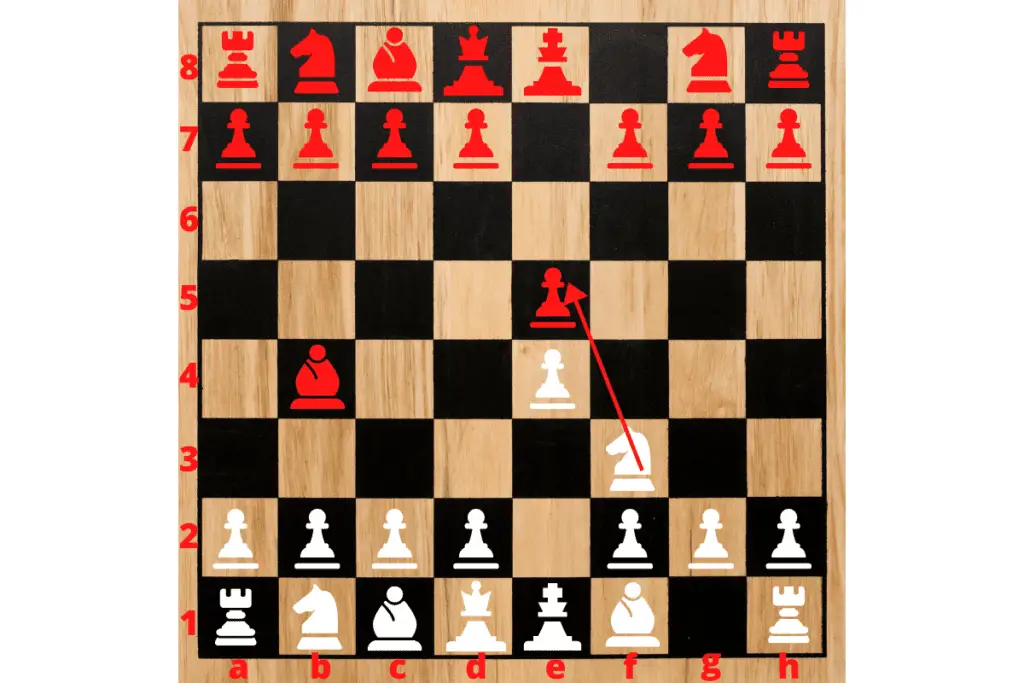
Learning Algebraic Chess Notation is Actually Easy
Many people are surprised at how easy learning Algebraic notation in chess is. Anyone can learn the basics of chess and notation in just 15 minutes and within an hour, you really should have everything you need to be able to write and record your own moves, and to be able to read, in conjunction with a visual board, all the moves from any game of recorded chess.
When I first saw algebraic notation written down I was somewhat intimidated by all these letters, numbers and funny-looking symbols and couldn’t begin to imagine how they could refer to the moves in a game of chess, and so I didn’t look again, and I didn’t learn them.
Years later, and in fact only when I began writing this blog after rediscovering the game of chess, did I think I needed to sit down and spend some time learning notation.
What enlightenment! Literally, within an hour a whole new world of chess had opened up to me, I understood what I was seeing in chess books and reading on chess websites like chess.com .
Now I was able to look at my games and see where I had made good moves and made mistakes and understand all of it in written form. I instantly became better at chess because I understood the game more fully.
FIDE and Algebraic notation.
FIDE recognizes only one form of notation, the Algebraic System, for its own events and matches, and it urges the use of this same uniform chess notation for chess books, magazines, and newspapers.
If the notation system used by the player’s scoresheet isn’t algebraic, they may not be presented as evidence in disputes or for results purposes.
If an arbiter of chess finds that a player is utilizing a different notation system on the score sheet than the algebraic, he or she should notify the player of this obligation.
Alternative Kinds of Chess Notation
Several other similar systems have been employed in addition to the FIDE algebraic convention already discussed but as mentioned are not acceptable for use in FIDE tournaments
Long algebraic notation
Long algebraic chess notation or fully expanded algebraic notation is a type of notation that includes the starting square as well as the destination square for a chess piece on a single move.
For example, in long algebraic notation, both the starting and ending squares are specified, for example, e4 in Algebraic notation would be noted as e2e4. The name makes perfect sense.
Sometimes these are separated by a hyphen, e.g. e2-e4, while captures are indicated by an “x”, in the same way, the x appears after the piece initial and before the square. so, e4xd5 for instance.
Long algebraic notation takes more space and is no longer commonly used in print or by chess players for that reason, although it has to be conceded, when in some cases there may be confusion of which, knight bishop or rook has been used in the official language, things are very clear using long algebraic notation.
Descriptive Notation
Until around 40 years ago, descriptive notation was an antique notation system for recording chess games in English, Spanish, and French chess literature.
Replaced by algebraic notation, which is less complicated not to mention much shorter and easier to record, the descriptive notation would already be considered quite antiquated given the language used.
This example of notation evolution shows how the algebraic abbreviated notation came to be
For example, the common opening move 1.e4 was originally recorded as “Pawn to King’s Fourth” or similar; by the time of Howard Staunton‘s The Chess-Player’s Handbook (1847), this had been abbreviated to “P. to K’s 4th.”; and later was further reduced to “P-K4”.
Wikipedia
ICCF numeric notation
Once you fully understand algebraic notation in chess, the ICCF numeric notation makes a whole lot of sense too, in rather than using letter and number combinations, only numbers are utilized.
This format was most commonly used in correspondence chess,
Transposing 1. e4, to 1. 5254 does on the face of things seem to make perfect sense, however, once the board was fully developed and the middle game was turning into the end game, things are not so clear.
Not to worry though, with the advent of the internet, email, and correspondence chess taking place more often online, the use of this numerical notation method has really faded away.







